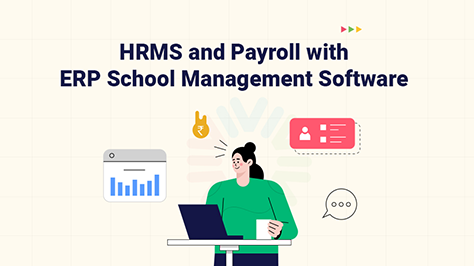HRMS and Payroll with ERP School Management Software
Efficient human resource management and accurate payroll processing are critical to running a smooth and effective educational institution. Traditional HR and payroll methods are often time-consuming, error-prone, and disconnected — leading to administrative overload and employee dissatisfaction.
This is where a school ERP system with integrated HRMS and payroll modules brings real value. Let’s explore how such a solution simplifies core HR functions, reduces errors, ensures compliance, and enhances staff experience.

Challenges in Traditional HR and Payroll Management
- Manual Data Entry
Leads to frequent errors in salary calculations and employee records. - Disconnected Systems
HR and payroll are often managed on separate platforms, causing data silos. - Compliance Risks
Staying updated with tax laws and labor regulations is difficult without automation. - Limited Access and Transparency
Employees and admins lack self-service tools, slowing down requests and reporting.
How ERP School Management Software Streamlines HR and Payroll
1. Centralized Employee Records
✔ All employee data — from personal details to job history — is stored in one secure place.
✔ Admins can access or update records instantly
✔ Staff can manage profiles, view payslips, or apply for leave via a self-service portal
2. Automated Payroll Processing
Payroll is calculated automatically based on rules for salary, taxes, bonuses, and deductions.
✔ Ensures timely and accurate salary disbursement
✔ Maintains full compliance with local labor laws and tax norms
✔ Reduces reliance on spreadsheets and manual approvals
3. Integrated Attendance and Leave Management
✔ Attendance integrates with biometric systems or digital logs
✔ Leave requests and approvals are handled online
✔ The system automatically reflects approved leaves in payroll
4. Performance and Appraisal Management
✔ Built-in tools for setting performance goals and conducting appraisals
✔ Managers can provide feedback and rate employee progress transparently
✔ Supports a culture of accountability and growth
5. Time and Expense Tracking
✔ Staff can log work hours and submit expense claims online
✔ Approval workflows ensure accuracy and timely reimbursements
✔ Time tracking helps in project costing and task management
6. Advanced HR Reporting and Dashboards
✔ Real-time dashboards show metrics like attendance trends, payroll status, and pending leave
✔ Customizable reports help admins analyze workforce performance, payroll costs, and compliance
✔ Data visualizations enable better decision-making
Benefits of ERP-Integrated HRMS and Payroll
- Improved Efficiency
Reduces repetitive work so HR staff can focus on strategic initiatives - Higher Accuracy and Compliance
Automation ensures correct calculations and legal compliance - Better Staff Satisfaction
Transparency, self-service tools, and timely payroll boost morale - Stronger Decision-Making
Real-time insights help institutions align HR with broader goals - Cost Savings
Fewer errors, faster approvals, and optimized processes reduce operational costs
Conclusion: Simplify Workforce Management with ERP-Integrated HRMS
Explore Bloombyte’s HR and Payroll ERP Solution to discover how your school can transform its workforce operations with a secure, compliant, and efficient system tailored for education.
